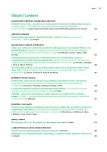Is it possible to improve long-term compliance of patients to statin therapy?
Authors:
Vladimír Soška 1,2,3; Ondřej Kyselák 1
Authors‘ workplace:
Oddělení klinické biochemie FN U sv. Anny v Brně
1; Katedra laboratorních metod LF MU Brno a II. interní klinika LF MU a FN u sv. Anny v Brně
2; Katedra laboratorních metod LF MU, Brno
3
Published in:
Vnitř Lék 2017; 63(10): 663-666
Category:
Reviews
Overview
Statins are key drugs for patients in secondary prevention of cardiovascular disease, as well as for primary prevention patients at high or very high risk of fatal cardiovascular events. However, long-term compliance of patients to statin therapy is relatively low, decreasing with the time of statin use; moreover a significant proportion of patients stop statins medication over the course of several years. To the early termination of statin treatment often contributes apprehension of the occurence of statin´s side effects (i.g. increased creatine kinase in the blood and muscle problems), although these symptoms are usually not causally related to statin therapy. To the low compliance may also contribute administration of statins in the evening hours, as well as the fear of developing diabetes or drug interactions. The above issues are discussed in the text of this article.
Key words:
compliance – creatinkinase – diabetes mellitus –LDL-cholesterol – statins
Sources
1. Baigent C, Blackwell L, Emberson J et al. Efficacy and safety of more intensive lowering of LDL cholesterol: a meta-analysis of data from 170 000 participants in 26 randomised trials. Lancet 2010; 376(9753): 1670–1681. Dostupné z DOI: <http://doi: 10.1016/S0140–6736(10)61350–5>.
2. Piepoli MF, Hoes AW, Agewall S et al. [2016 European Guidelines on cardiovascular disease prevention in clinical practice]. The Sixth Joint Task Force of the European Society of Cardiology and Other Societies on Cardiovascular Disease Prevention in Clinical Practice (constituted by representatives of 10 societies and by invited experts): Developed with the special contribution of the European Association for Cardiovascular Prevention & Rehabilitation (EACPR). Eur Heart J 2016; 37(29): 2315–2381. Dostupné z DOI: <http:/doi: 10.1093/eurheartj/ehw106>.
3. Skoupá J. Dlouhodobá adherence ke kardiovaskulární farmakoterapii v České republice na příkladu amlodipinu a atorvastatinu. Kapitoly z kardiologie 2011; 3 : 63–67.
4. Jackevicius CA, Mamdani M, Tu JV. Adherence with statin therapy in elderly patients with and without acute coronary syndromes. Jama 2002; 288(4): 462–467.
5. Chowdhury R, Khan H, Heydon E et al. Adherence to cardiovascular therapy: a meta-analysis of prevalence and clinical consequences. Eur Heart J 2013; 34(28): 2940–2948. Dostupné z DOI: <http://doi: 10.1093/eurheartj/eht295>.
6. Wallace A, Chinn D, Rubin G. Taking simvastatin in the morning compared with in the evening: randomised controlled trial. BMJ 2003; 327(7418): 788. Dostupné z DOI: <http://doi: 10.1136/bmj.327.7418.788>.
7. Tharavanij T, Wongtanakarn S, Lerdvuthisopon N et al. Lipid lowering efficacy between morning and evening simvastatin treatment: a randomized double-blind study. J Med Assoc Thai 2010; 93(Suppl 7): S109–113.
8. Lund TM, Torsvik H, Falch D et al. Effect of morning versus evening intake of simvastatin on the serum cholesterol level in patients with coronary artery disease. Am J Cardiol 2002; 90(7): 784–786.
9. Catapano AL, Graham I, De Backer G et al. 2016 ESC/EAS Guidelines for the Management of Dyslipidaemias. Eur Heart J 2016; 37(39): 2999–3058. Dostupné z DOI: <http://doi: 10.1093/eurheartj/ehw272>.
10. Rallidis LS, Fountoulaki K, Anastasiou-Nana M. Managing the underestimated risk of statin-associated myopathy. Int J Cardiol 2012; 159(3): 169–176. Dostupné z DOI: <http://doi: 10.1016/j.ijcard.2011.07.048>.
11. Stroes ES, Thompson PD, Corsini A et al. Statin-associated muscle symptoms: impact on statin therapy-European Atherosclerosis Society Consensus Panel Statement on Assessment, Aetiology and Management. European Heart Journal 2015; 36(17): 1012–1022. Dostupné z DOI: <http://doi: 10.1093/eurheartj/ehv043>.
12. Kashani A, Phillips CO, Foody JM et al. Risks associated with statin therapy: a systematic overview of randomized clinical trials. Circulation 2006; 114(25): 2788–2797. Dostupné z DOI: <http://doi: 10.1161/CIRCULATIONAHA.106.624890>.
13. Bruckert E, Hayem G, Dejager S et al. Mild to moderate muscular symptoms with high-dosage statin therapy in hyperlipidemic patients – the PRIMO study. Cardiovasc Drugs Ther 2005; 19(6): 403–414. Dostupné z DOI: <http://doi: 10.1007/s10557–005–5686-z>.
14. Bednařík J. Toxické a lékové myopatie. Neurológia pre prax 2004; 3 : 145–148.
15. Arca M, Pigna G. Treating statin-intolerant patients. Diabetes Metab Syndr Obes 2011; 4 : 155–166. Dostupné z DOI: <http://doi: 10.2147/DMSO.S11244>.
16. Soska V, Vaverkova H, Vrablik M et al. Opinion of the Czech Atherosclerosis Society‘s committee (CSAT) on the ESC/EAS guidelines related to the diagnostics and treatment of dyslipidemias issued in 2011. Vnitr Lek 2013; 59(2): 120–126.
17. Bultas J. Vzájemné srovnání statinů z pohledu farmakologa. Remedia 2013; 23(2): 143–150.
18. Sattar N, Preiss D, Murray HM. Statins and risk of incident diabetes: a collaborative meta-analysis of randomised statin trials. Lancet 2010; 375(9716): 735–742. Dostupné z DOI: <http://doi: 10.1016/S0140–6736(09)61965–6>.
19. Carter AA, Gomes T, Camacho X et al. Risk of incident diabetes among patients treated with statins: population based study. BMJ 2013; 346: f2610. Dostupné z DOI: <http://doi: 10.1136/bmj.f2610>.
20. Sukhija R, Prayaga S, Marashdeh M et al. Effect of Statins on Fasting Plasma Glucose in Diabetic and Nondiabetic Patients. Journal of Investigative Medicine 2009; 57(3): 495–499. Dostupné z DOI: <http://doi: 10.2310/JIM.0b013e318197ec8b>.
21. Ridker PM, Pradhan A, MacFadyen JG et al. Cardiovascular benefits and diabetes risks of statin therapy in primary prevention: an analysis from the JUPITER trial. Lancet 2012; 380(9841): 565–571. Dostupné z DOI: <http://doi: 10.1016/S0140–6736(12)61190–8>.
Labels
Diabetology Endocrinology Internal medicineArticle was published in
Internal Medicine

2017 Issue 10
Most read in this issue
- COSYREL – an efficient fixed combination for treatment of hypertension, stable ISHD and heart failure
- Surgical treatment of aortic root aneurysm: comparison of Bentall procedure and David reimplantation of aortic valve
- Physical activity – the Holy Grail of modern medicine?
- Endocrine orbitopathy: the present view of a clinical endocrinologist
